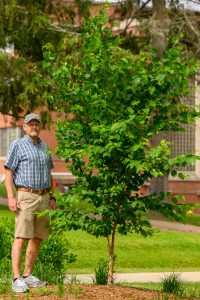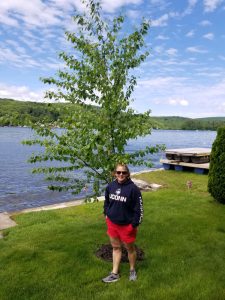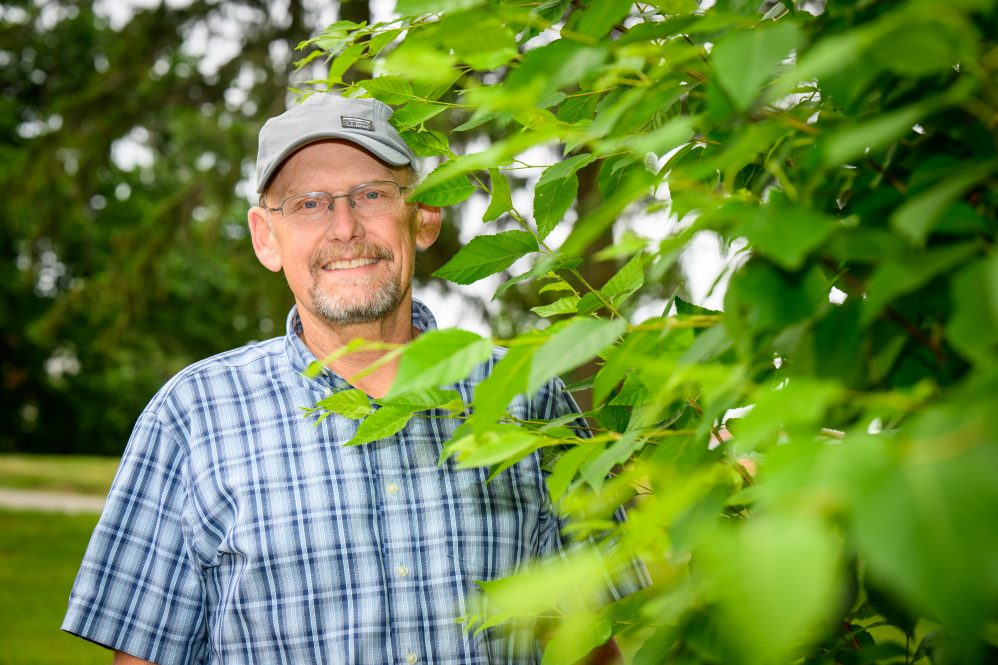Just as new generations of UConn students are coming to its campuses each fall, a new generation of rare Dahurian birch trees – descendants of the iconic Mirror Lake “swing tree” – are thriving in the midst of the Storrs campus.
The “swing tree” provided shade, recreation, and inspiration to generations on campus until it had to be removed in 2019 because it had reached the twilight of its natural life and was dying, creating a safety hazard.
But just as generations of UConn graduates watch their children and grandchildren follow in their footsteps each year, four of the swing tree’s descendants have also taken root – literally and figuratively – on Swan Lake’s south side as a continuing and special piece of campus history.

“This kind of birch likes moist soil and they don’t respond well when subjected to extreme heat, so this is a very nice spot for them,” Mark Brand, a UConn professor of horticulture in the College of Agriculture, Health and Natural Resources, said recently while pointing out the healthy young trees on a refreshing summer morning.
“The original Dahurian birch meant a lot to many people,” said Brand, who collected its seed-carrying catkins from the original swing tree in 2018 to continue the line by growing saplings. “Having not known how the new plantings would do, it’s nice to see them growing so well.”
The Dahurian birch, also known as an Asian black birch, is rare in the U.S. and usually only seen at arboreta, botanical gardens, and some university campuses.
UConn’s birch was one of two originally planted near Mirror Lake, and was about 70 years old – about the natural end of that species’ typical life — when it started to fail in 2018, prompting the need to remove it a year later despite attempts to bolster its health.
It was special to generations of UConn students who enjoyed the tree’s shade on sunny days, sat under it to watch ducks and birds, enjoyed the two swings that were added to its branches in the early 2010s, and wrote in the community journal placed nearby for the last three years of the tree’s life.
Now, two of its successors are growing quickly near a garden and benches installed by Swan Lake in fall 2020 to commemorate the original tree, and two others are planted nearby to the east of the benches near the lake’s south shore.
Unlike the original birch near Mirror Lake, the new trees will not have swings added to them; the young branches would not respond well to the stress, and the soil at the roots needs to be loose enough for water to seep through, not compacted by people standing or walking on those spots.
The Dahurian birch species is native to northern China, Korea, and Japan, and specimen trees usually range from about 40 to 60 feet at maturity, according to the UConn Plant Database.
Also known by its scientific name, Betula davurica, UConn’s swing tree was the only known example of that species in this region and was frequently photographed, including when it used to be lit up during the holidays while it was still in good health.
A second Dahurian birch tree once grew on campus on the opposite side of Mirror Lake, but that tree fell victim to the bronze birch borer insect about 15 years ago.
The UConn Storrs campus is an arboretum in itself due to the number and variety of trees planted over the years on its acreage, many of which are unusual species that aren’t native to the area and were specifically selected to add diversity and beauty.
The UConn Arboretum Committee works with University offices and departments to oversees plans to care for the 5,096 trees identified as currently existing on its Storrs campus, including the Dahurian birch “swing tree” successors near Swan Lake.
In addition to those birches, several other swing tree descendants are believed to be planted throughout the region by people who purchased or received them in 2019 when they were being sold as saplings to raise money for the Class Tree Project fund.

One of the first was a going-away gift for Elizabeth “Betsy” Cracco, the former UConn Counseling & Mental Health director who originated the swing tree journal.
Now thriving at her family’s lakefront cottage in northwestern Connecticut, the sapling that was less than two feet tall in May 2019 towers over her at 18 feet tall and is developing the unmistakable curling bark of its species.
“The thing with the swing tree at UConn that so astounded me was how much students felt a personal bond to it,” Cracco says. “Some of my favorite passages in the swing journal were students writing to the tree when it was dying, thanking it for being a comfort to them. I just think the tree was a place of safety and refuge, and that really is a foundational element of healing.”



